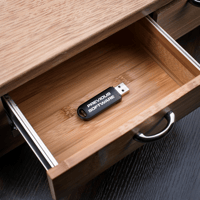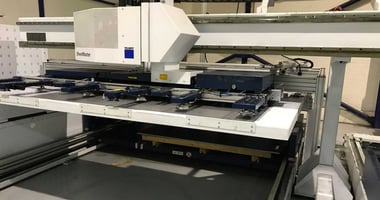With over 38 years in the industry, JETCAM has thousands of customers around the world. However,...
64-bit: What is it, and why is it important?

64-bit technology in mainstream computing can be traced back to the 1990s, but it wasn’t until the mid-2000s, 64-bit operating systems became more common, with Microsoft launching a 64-bit version of Windows XP Professional in 2005. Now, all computers are supplied with 64-bit as standard but what is it, and what are the benefits?
What is 64-bit Technology?
To see the value of 64-bit technology, you need to understand what the term means. At its core, the difference between 64-bit and 32-bit refers to the data width that processors can handle. In simple terms, 64-bit systems can process much larger chunks of data and access significantly more memory than 32-bit systems. Think of it as motorway lanes between the CPU and other elements of the hardware. More lanes equal more data that can travel at the same time. This capability provides higher performance levels and the ability to run more complex and memory-intensive applications efficiently.
In terms of memory, the core difference between 32-bit and 64-bit systems lies in their capability to access and utilise RAM. A 32-bit system can access 4 GB of RAM of physical memory. This limitation means that a 32-bit system will have less memory to share between applications. A 64-bit system can access a much larger amount of RAM—practically, 18-quintillion bytes of RAM, providing a significant improvement in performance for processes such as nesting that require substantial memory resources.
How to check if you are running a 64-bit version of Windows
To check if you are running a 64-bit version of Windows click Start > Settings > System > About. Under Device specifications, it should show whether you’re running a 64-bit or 32-bit version of Windows. This process may vary slightly depending on the version of Windows you are running.
While you can of course run 32-bit apps on 64-bit operating systems seamlessly, they cannot take advantage of the performance benefits of 64-bit e.g. they are limited to accessing 4GB of RAM, and use the WOW64 subsystem on Windows, which itself introduces a performance overhead that could potentially affect the speed and efficiency of any 32-bit app running on a 64-bit OS.

Above: A Windows 10 computer showing the system type as 64-bit
The Advantages of 64-bit JETCAM Expert
The introduction of JETCAM Expert in a 64-bit version brings a host of benefits to the table. With the ability to access more RAM, JETCAM Expert can now perform complex nesting operations much faster than ever. Specifically, this will aid customers producing complex nests with a larger number of components.
While there will be minor performance benefits across the board, users are most likely to see significant material savings when using 64-bit in conjunction with either High Performance or Ultra Performance nesting modules. As these are time-based algorithms, being able to access much more RAM and the additional bandwidth that 64-bit provides will deliver a significant performance increase. Either you will be able to generate the same level of efficiency against a nest much quicker, or you can leave the nesting time the same and benefit from potential further savings, as the nester will be able to use more memory and run processes much faster.
What are the costs of switching from 32-bit to 64-bit?
Firstly, you need to ensure that your hardware, namely the CPU, can support 64-bit. As all Intel processors from 2004 onwards support 64-bit, unless you are running a very old PC, 64-bit operating systems will run on it.
If you are running a supported version of Windows (currently Windows 10 or 11), the chances are that you are already running a 64-bit version of Windows. In the unlikely scenario that you are not, speak to your IT vendor about what is involved in either upgrading Windows on your current PC, or replacing it altogether.
Microsoft make no charge to switch to a 64-bit version of the same licensed operating system. You can download installation media from their website using the Microsoft Media Creation Tool.
Finally, and most importantly, JETCAM users under maintenance can download and install either the 32-bit or 64-bit version free of charge.
So, it’s most likely that switching to 64-bit is going to cost you nothing, and you are likely to have everything you need, in terms of hardware and operating system, to make the switch.
Upgrading JETCAM Expert from 32-bit to 64-bit
JETCAM Expert is available in both 32-bit and 64-bit from version 24.03.02. If you are performing a fresh installation (e.g., not upgrading an existing instance), the process is as normal.
Upgrading an existing 32-bit instance to a newer (high version number) 64-bit version is also simple. Just run the installer as normal, selecting the instance that you want to upgrade. (JETCAM Expert allows up to 25 instances to be installed. You can then choose which ones to upgrade – this is useful if you run ‘development’ instances to test newer releases before rolling them out to production.)
If you wish to switch the same version of Expert between 32-bit and 64-bit you will need to deinstall the current version first and then install the same version number with the alternative architecture. During deinstallation you can select to keep your existing data, so after running the installation routine your software will work as normal. We do recommend taking a backup of all files before upgrading or switching versions, just to be safe.
Note: The file structure between the same version numbers of 32-bit or 64-bit versions does not change. You can safely switch between a 32-bit and 64-bit version (and back again, if need be) without concern that your parts and nests will not be compatible, as long as you reinstall the same version number.
Other products, such as JETCAM Orders Controller (JOC) and CrossTrack will also have 64-bit versions released in the future.
Summary
Our move to 64-bit demonstrates our commitment to providing users with the most advanced, efficient, and reliable solutions on the market. We are not just keeping pace with developments; we are staying ahead, future-proofing the software and ensuring that our customers always have the edge they need to succeed.
%20(Custom).jpg?width=1000&height=252&name=JETCAM%20logo%20(glossy%20effect)%20(Custom).jpg)


